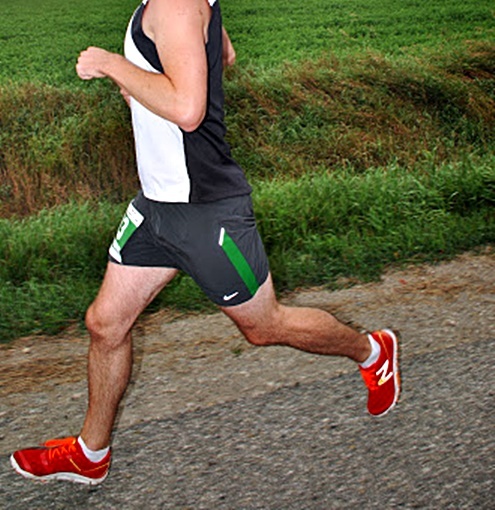The reason heel striking when running is bad form is that to date, there’s more than enough conformational data showing that heel strike running causes significantly more injuries than forefoot running because landing heel-first always accompanies exponential impact whereas landing forefoot-first never produces these excessive impacts. This is why you are a better off as a forefoot runner. Want more proof?

Over the past few decades, research has consistently pointed to the high impact nature of heel strike running that directly causes most injuries, especially severe injuries, like long bone injuries and knee cartilage degeneration (knee osteoarthritis).
Worse still, in addition to producing higher-than-normal impacts, heel strike running also produces an assortment of physical stressors, such as increased foot step instability (over-pronation) as well as more bending strain and rotational stress on the achilles, shins, knees and hips. It also causes your upper body to tilt too far back, resulting in a greater over-stride angle which is inefficient and ineffective as counters gravity and causes the body to come to crashing halt for too long.
- The farther back you land on your heel, the farther the over-reach of the foot out in front of your body, the more the knee unbends. This directly pushes your upper body backward, creating a longer distance separation between initial foot strike position and the upper body. This is why landing heel-first is not a functional way for the foot to connect with the ground when running.
In that regard, here’s the long-list of injuries intrinsically linked to heel strike running that are perfectly prevented with forefoot running:
Metatarsal Stress Bone Fracture – Heel strike running was found to alter plantar (foot) pressure distribution in ways that increased stress on the metatarsal heads. Read more here!
Knee Problems – The peak impact and compressive forces produced at heel strike slaughters the knee cartilage, causing knee osteoarthritis! Read more here!
Broken Femur -That’s no typo: runners who heel strike, especially over long distances, have too much impact forces travelling through their leg that is eventually overheats and breaks the strongest bone in the body, the femur! Read more here!
Achilles Injury – The foot is well-known to grapple more with ground in heel strike running, resulting in over-pronation (the heel is forced into extreme positions during stance). This increase bending strain and torsion on the Achilles tendon. Read more here!
Lower Leg Pain – Chronic leg pain and heel strike running always go hand-in-hand because its the only running style to cause lower leg intramuscular pressure to rise to pain-inducing levels. Read more here!
Heel Pain – The heel pad is strong enough for walking with a heel strike, but not running, heel strike as it was found to reduce blood flow in the heel pad, leading to deformations and a complete loss of shock absorption of the heel pad! Read more here!
Ankle Inversion Injury – Because landing on the heel when running causes the foot rapidly move out of neutral line, forces the ankle to work harder at trying to stabilize foot instabilities. Read more here!
Lower Back Damage – The high impact of heel striking doesn’t damage the leg! It’s so severe that it travels up the back where it was found to causes structure damage to the lower back! Read more here!
Degenerative Joint Disorders – Because you are overloaded with impact when heel strike running, it will eventually wear down your joints. Read more here!
ITBS – In heel strike running, the foot spends more time on the ground, especially more time spent in the impingement range of knee flexion angles, placing high strain on the IT band. Read more here!
It’s become more apparent about the precise ways injuries will always remain a component of heel strike running. Here are the many examples research has provided for us showing exactly how heel strike running causes injury:
High loading – Increases the rate of loading beyond tolerable biological limit.
Impact Peak – This is makes your knee and hip joints hurt.
Heel-Strike Transient – The main reason heel strikers get injured.
High Ground Reaction Forces – The high ground reaction force is what separates heel strike from forefoot strike running in that this force is probably the number one reason heel strike runners get plagued with so many chronic injuries.
Compressive Forces – At heel strike, in addition to the ground reaction force, a massive compressive wave is naturally generated and is linked to ITBS.
If you’d like, you can support Run Forefoot and help keep it going by making a donation in any amount of your choosing:

Or, you can also support Run Forefoot by shopping at the following top minimalist shoes brands, and be sure to bookmark the links:
Be Lenka: https://www.dpbolvw.net/click-7600968-14330828
FeelGrounds: https://www.feelgrounds.com/?p=RunForefoot
Xero Shoes: https://xeroshoes.com/go/Run_Forefoot
Iguaneye: https://www.iguaneye.com/?ref=8tfXVc92
Soft Star Shoes: https://shrsl.com/3mp1b
Wilding Shoes: https://bit.ly/3lIygQP
Earth Runners: https://earthrunners.com/?rfsn=6763579.f7f9c9
Vivobarefoot: https://shrsl.com/3kvih
Zappos: https://goo.gl/J1CeAd
Bretta Riches
BSc Neurobiology; MSc Biomechanics candidate, ultra minimalist runner & founder of RunForefoot. I was a heel striker, always injured. I was inspired by the great Tirunesh Dibaba to try forefoot running. Now, I'm injury free. This is why I launched Run Forefoot, to advocate the health & performance benefits of forefoot running and to raise awareness on the dangers of heel striking, because the world needs to know.
Latest posts by Bretta Riches (see all)
- Can You Run In Barefoot Shoes? Yes, But DON’T Heel Strike! - 21/07/2024
- Why Cushioned Running Shoes Are Really Bad for Your Feet - 19/07/2024
- Do Cushioned Running Shoes Cause Injuries? - 17/07/2024


where is the evidence?
adu2eh
us5bsj